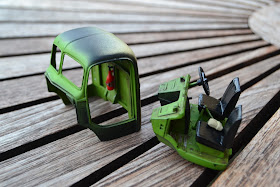Not just two
French locomotives ended up at Nystrup Gravel because of the world war. A year ago a friend sent me a few photos. He had explored into one of the birch forest covering what was once the northernmost gravel pit of Nystrup Gravel. His photos showed a huge tracked tractor with cyrillic letters on the broken off radiator and faded white letters 'FluPlaKo' on the rear plate.
 |
| Two images of the rusting remains of a Soviet S-65 in one of the old gravel pits around Nystrup. Today a wilderness of birch forest difficult to navigate. Thanks to friend, explorer and railway enthusiast J. Jensen for his images. |
Now I have determined that two Soviet tracked tractors found their way to Nystrup Gravel. The tractors were used by the Germans to pull aircraft at the air field at Mellemåen (Middle Stream) not far from Nystrup. Again a case where the German military utilized captured enemy equipment as best they could. According to British documents found in the Skovby Local Historical Archive 'FluPlaKo' is an acrynom for 'Flug-Platz Kommando'.
The S-65 tractors were Soviet copies of the American Caterpillar 60. The Soviet version was built at the
Chelyabinsk Tractor Factory in the Urals in large numbers for both agricultural and military use. In the Soviet army they were primarily used to pull medium and heavy artillery. Large numbers were captured by the German army in the opening stages of the attack on the Soviet Union. A
brief history of the S-65. Somehow two of them found their way to Denmark. The huge
Chelyabinsk factory still exists today, continuing to produce tracked tractors.
Nystrup Gravel used one of the tractors to haul cut down trees away from areas to be quarried. The other was used for spares. Not much of a chance for delivery of spare parts from Chelyabinsk to the Danish countryside!
I went straight to my local hobbyshop in Copenhagen -
Stoppel Hobby - to shop for
Trumpeter's kit of the S-65 (kit no 05538). My 1:35 version of Nystrup Gravel also has to have an S-65.








